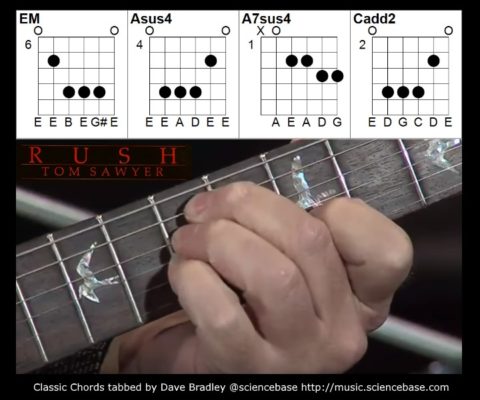Tom Sawyer is perhaps the best known Rush song. It was the Canadian power trio’s breakthrough hit in terms of sales and popular appeal and was the opener on their 1981 album Moving Pictures. I remember listening to it on vinyl the day it came out and wondering how on earth I was going to work out what Lifeson was playing in terms of chords.
Lyrically, the song strikes out as the eponymous rebel with words by Rush drummer/lyricist Neil Peart and Pye Dubois who wrote lyrics for fellow Canadian rockers Max Webster. The opening power chords that share Le Studio space with Geddy Lee’s Moog synths and a spaced out backbeat from Peart are not your common or garden no-third power chords as you’d imagine, nor were they anything like the open, up-the-neck chords he’d been using in the previous decade (cf The Hemispheres chord).

If they were standard power chords, it would probably just be a big E-major followed by a D and an A and then jumping down to the C. But, Lifeson, who pleads ignorance of most of the chord names in the video tutorial he recorded for the song in 2007, is playing some interesting variations on the power chord idea. In them, an open top E string rings out in the intro on three of four chord variations that give us the progression.
There is (admittedly) a massive E-major power chord at the seventh fret (although by definition because it’s got the third note of the scale of E major (G#) it’s not really a proper power chord). Open bottom E string leads the riff into the sustained power chord. The second chord is an Asus4 (but with the open top E string to add chorus-like resonance to the E fretted on the B string, that too kicks off with an open E string for the riff. The third chord starts with the open A string instead and sustains an A7sus4, which lifts that almost jazzy-sounding second chord, the As4. And, finally kicking with the bass E string open again we move two frets down from the second chord shape to give us a hybrid chord a Cadd2 (basically a C major chord with the second note of the scale of C major, the D, added, you might also called it a Cadd9).
I remember the chords in the Rush music book I had as a kid, they had it as E, Dsus4, A, and then C. It was wrong…well…it was simplifed if not wrong. Any tab and chord sites that talk of E, D, A and C major power chords as being the chords in Tom Sawyer are just plain wrong too. Some seem to get it half right, but Alex himself shows you exactly what he plays here and that’s how I’m playing it on this snippet: